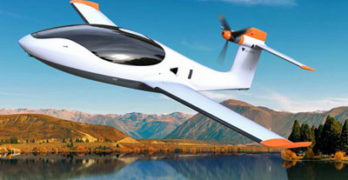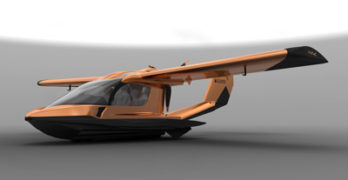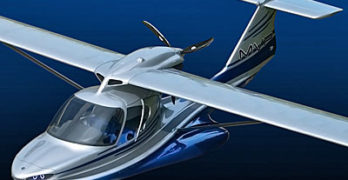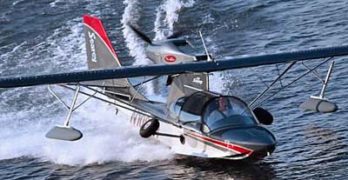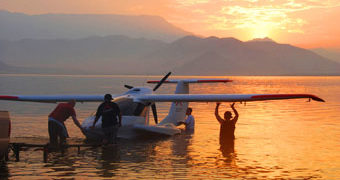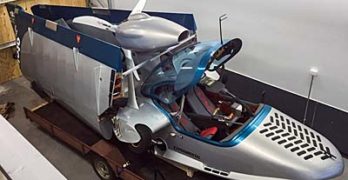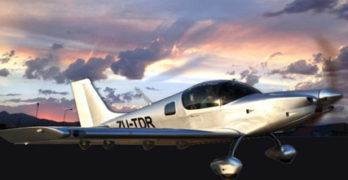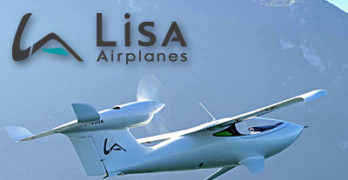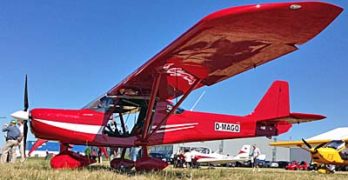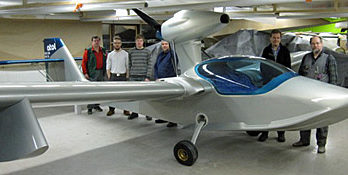If you’ve been following exciting developments like the Airbus/Pipistrel/Cri-Cri English Channel crossing, or for that matter any of the electric airplane developments, you should know that the ideal electric-powered aircraft today are the very lightest weight machines.
However, another quality is just as important while we wait for scientists to significantly amp up the energy density of batteries. That quality is sleekness and I’ve been watching a Norwegian project from Equator Aircraft. Airplanes don’t get much sleeker than this.
If it needed to be even more intriguing, consider that this project comes from a team that has also been involved with seaplanes, so how about a two-seat electric seaplane? OK, it isn’t ready yet but this is one I will continue to follow closely. Following is some detail on this fascinating entry that again suggests the tip of the spear in LSA design seems intently focused on seaplanes.
Equator’ Aircraft P2 Excursion (abbreviated EQP2) is envisioned as a performance hybrid amphibian aircraft.
Search Results for : Icon A5
Not finding exactly what you expected? Try our advanced search option.
Select a manufacturer to go straight to all our content about that manufacturer.
Select an aircraft model to go straight to all our content about that model.
Riding the Wave … Vickers’ Wave, That Is
As I’ve written a few times, I see a dichotomy in LSA designs. Landplanes appear to have entered a “mature” phase, where changes are incremental, evolutionary rather than revolutionary, if you will. I see nothing wrong with that. To the contrary, it speaks to an industry that knows where it is going and how to achieve design goals. Electric propulsion is still stirring things considerably (witness several recent articles here and elsewhere) but electric motors can work on landplanes or seaplanes.
To my view, it appears the lead in the most innovative design is being done in LSA seaplanes. Perhaps this was triggered by Icon and their A5. The California entry is handsome and well enough marketed to collect many orders. While finally coming to market A5 has been a decade in preparation. This left the door open for more highly innovative entries
Meanwhile existing designs such as Searey and Super Petrel have been much refined and have demonstrated meeting ASTM standards with Searey also achieving Chinese Type Design Approval.
MVP Traveling to Europe and Touring USA
In the first decade of Light-Sport Aircraft we saw a new model emerge nearly every month; some months brought more than one model. SLSA approvals reached 136 aircraft, most of them land-based aircraft (our SLSA list describes each type).
To general aviation pilots used to a genuinely new aircraft model once a decade or so, this LSA development outpouring was phenomenal. Cirrus SR20 was certified 17 years ago in 1998; how many other all-new GA models can you name since?
By 2015, the torrid pace has slowed for various reasons and now we see more incremental changes on Light-Sport Aircraft, by which I mean new engines, interior changes, new avionics or other features, and so forth. This is much like in the GA world and I see nothing wrong with that, but it is less inspiring than a constant flow of brand-new concepts.
Rushing into this all-new-design gap like a tsunami filling a Pacific atoll are LSA seaplanes.
Searey Announces Financing … Riding the Wave
While some beautiful looking LSA seaplanes have captured lots of attention — here I am thinking of Icon’s vigorously promoted A5, the unusually capable MVP, the highly innovative Wave, and Finland’s ATOL … all of which have some fascinating features — all but one of these share one feature: you can’t get one yet. ATOL is preparing to deliver but A5, MVP, and Wave are all still works in progress. It takes time to develop a new aircraft but today if you want a ready-to-fly seaplane in the USA, you have basically three choices: SeaMax, Super Petrel LS, and Searey. Of those, Super Petrel has airplanes in stock in the USA and ready for delivery.
Searey stands along in my view as an LSA seaplane you can buy today and receive in a reasonable timeframe.
It’s Winter, So Seaplanes Are Flying … Uh, What?
On this website, we zoom around the world following Light-Sport Aircraft, from near the Arctic Circle — you know, where Santa and the wee elves are pulling some heavy overtime about now — to the warm balminess of Southern California. I know of what I write, having once lived in the snow belt and now hanging with the family in Palm Springs, California for Christmas. It seems everywhere I look I see LSA seaplanes in sea trials and this is happening in the dead of winter.
Why be surprised? Perhaps you’ve noticed boat shows happen in the winter months. When living in Minnesota, I was always amazed that boat shows were held in January and February, a time of year when it would be months before the ice melted from the state’s 10,000 lakes to allow use of those boats. Yet this is when people were shopping, I suppose anticipating an upcoming season of boating fun.
Finland’s Atol Amphib Begins Water Tests
Ah, the Christmas season is soon upon us (or already is judging by familiar music playing on every speaker you hear). It sounds like a great time to go put your new seaplane in the water … especially if you live up by the Santa Claus toy workshop. Wait a minute! Can that be right? Yup! Atol Avion Ltd., recently notified us, “We have finally performed first water taxi tests of our production prototype on December 14th, 2014 at Rovaniemi, Finland. After thorough systems tests, water taxi tests were performed on Kemijoki River near the Arctic Circle … just a few miles from Santa’s home. Our plane worked as planned and proved to be even better than expected.”
As a Florida resident, I have plenty of local acquaintances that think such an exercise sounds crazy, to be out water testing an amphibious airplane in winter. They mean here in Florida where it’s on the cool side … you know, 50s and 60s.
LSA Taildraggers Broaden the Sector’s Appeal
Taildraggers may be among the least understood and most feared aircraft available in the LSA space … or for that matter throughout general aviation. While we have many good choices that I’ll list below, I have nonetheless heard from many readers or airshow visitors that they are uncertain about their operation of an aircraft that has no nosewheel. If you have no taildragger skills, you’ll also find it a challenge to get proper flight instruction in a “standard” aircraft. For those seeking new skills in flying, however, taildraggers may provide high satisfaction. Most who have crossed the barrier to taildragging subsequently look very fondly at such aircraft, seeing a sleeker yet gutsier, more rugged appearance. Of course, nosewheels dominate general aviation as they can be easier to land, especially in crosswinds, but once you learn the lesson of “happy feet” — or keeping your feet active on the rudder pedals throughout approach and touchdown — you may always yearn for more taildragger time.
Amazing LSA Seaplanes: Lisa’s Supersleek Akoya
We just passed September 1st and that date is significant in the LSA universe. It is the day, ten years ago, that the Sport Pilot & Light-Sport Aircraft rule we have been celebrating all summer officially became part of the Federal Aviation Regulations (FARs). If you’re thinking, “Hey, I thought it was announced in the summertime, at AirVenture!” … you’re correct. It was, but that was just the administrator’s public relations timing to get the biggest bang for the buck, at Oshkosh. As we continue the tenth anniversary celebration — looking back on the first decade — we see the astounding development of 136 models of LSA, more than one every month for ten years running. This profusion of models runs the length and breadth of aviation, from fixed wing, three axis airplanes to powered parachutes to trikes to motorgliders and from less than $30,000 to over $200,000. I fully expect designers to continue pushing the envelope in every direction but one facet of LSA development seems as energized as a Saturn V moon rocket: LSA seaplanes.
Flying Serbia’s Light-Sport Aircraft Entry
Update April 13, 2018 — At Sun ‘n Fun 2018, I was shown documents and photos to suggest the problem was the opposite of what appears in the following paragraph. Without legal discovery, for which I am not qualified, it is challenging to sort out the truth, however, based on the four years of history that has followed this story, I’m inclined to believe Aeroeast is a legitimate producer. In any event, as the aircraft has since changed in many ways, I consider the matter closed and wish Aeroeast good success in the future. —DJ
Update August 10, 2014 — At AirVenture 2014, I was informed that Aero-East-Europe’s Sila 450 is significantly based on a Max Tedesco design. When I heard this comment, I recall I had looked at the Serbian aircraft featured in the following article and thought it looked vaguely familiar. Many aircraft designs share a resemblance so I didn’t think much of it and I was no where near any of Tedesco’s airplanes to have a comparison.
LSA Seaplanes Remain Newsworthy in 2014
Someone remarked to me recently that LSA seaplanes seem to be the topic of the week or month (or however often you check in to see). Indeed, as we approach the tenth anniversary of Sport Pilot / Light-Sport Aircraft, we can reflect with pride upon more than 130 models making their way to market. True, not all have proven successes in the market place but having choice is always good for customers even if they finally select from a limited number of brands to occupy their hangar. Therefore, thanks to all those entrepreneurial designers that brought new airplanes to the sky. Now, in the closing months of LSA’s first decade, a new focus appears turned to amphibious Light-Sport machines, with more than 20 vying for our attention. As always some are doing a better job of capturing mindshare than others. In this article I’ll talk about two from nearly opposite ends of the new spectrum.


